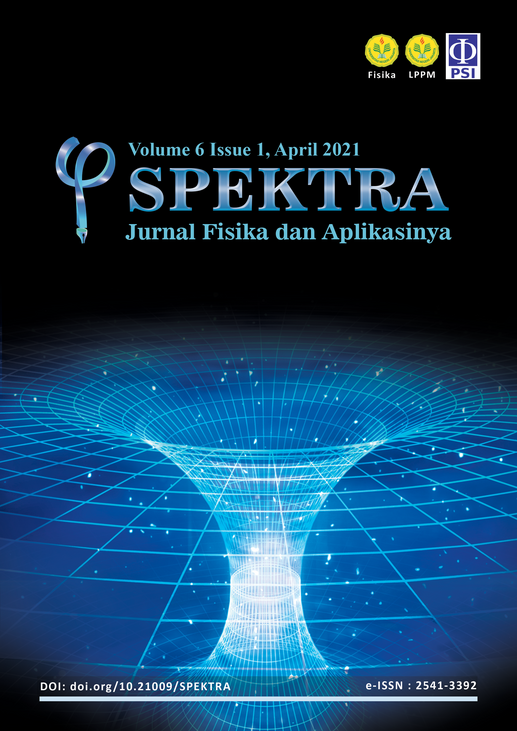SIMULATION OF PEAK GROUND ACCELERATION AND PSEUDO SPECTRAL ACCELERATION OF PALU EARTHQUAKE SEPTEMBER 28TH 2018
DOI:
https://doi.org/10.21009/SPEKTRA.061.06Keywords:
peak ground acceleration, spectrum acceleration, GMPE, NGA, Palu earthquakeAbstract
The devastating earthquake Mw 7.4 hit Palu City, Central Sulawesi on September 28th, 2018, at 17:02:44 WIB. A high tsunami followed it. More than 2000 people died as a result of the earthquake and tsunami disaster. The latest evidence shows that the earthquake was categorized as a rare super shear earthquake. The earthquake shaking that hit Palu City is relatively large. Acceleration data are not available at the study site due to the lack of instrumentation in the area. The Authors present a simulation of peak ground acceleration (PGA) and pseudo-spectral acceleration (PSA) due to the earthquake in three locations Tatura Mall, Roa-Roa Hotel, and Antapura Hospital. PGA describes the maximum acceleration on the ground, while pseudo-spectral acceleration describes the acceleration of earthquake shaking from buildings with various floor numbers. Simulation of PGA and PSA to the three sites used three different Ground Motion Prediction Equation (GMPE) functions, BSSA14, CB14, and CY14, with the weighting of each Next Generation Attenuation (NGA) GMPE functions. The results of PGA simulation is about 0.22-0.23 g and show that in the three study site, it is more vulnerable to spectral acceleration period T=0.3 s or building with three floors or about 1-15 floors. These correlate with the level of damage caused by earthquakes which is more impact to relatively higher buildings.
References
[2] Badan Pusat Statistik, “Sensus Penduduk 2010,” 2019, diakses online https://sp2010.bps.go.id/index.php/site?id=72&wilayah=SulawesiTengah.
[3] O. Bellier et al., “High Slip Rate for a Low Seismicity along the Palu Koro Active Fault in Central Sulawesi (Indonesia),” Blackwell Science Ltd, Terra Nova, vol. 13, pp. 463- 470, 2001.
[4] Bidang Seismologi Teknik BMKG, “Ulasan Guncangan Tanah Akibat Gempa bumi Donggala 28 September 2018,” Jakarta, 2018.
[5] P. Bird, “An updated digital model of plate boundaries,” Geochem. Geophys. Geosyst, vol. 4, no. 3, pp. 1027, 2003, doi:10.1029/2001GC000252.
[6] D. M. Boore et al., “NGA-West2 Equations for Predicting PGA, PGV, and 5% Damped PSA for Shallow Crustal Earthquakes,” Earthquake Spectra, vol. 30, no. 3, pp. 1057-1085, 2014.
[7] K. W. Campbell and Y. Bozorgnia, “NGA-West2 Ground Motion Model for the Average Horizontal Components of PGA, PGV, and 5% Damped Linear Acceleration Response Spectra,” Earthquake Spectra, vol. 30, no. 3, pp. 1087-1115, 2014.
[8] B. S. J. Chiou and R. R. Youngs, “Update of the Chiou and Youngs NGA Model for the Average Horizontal Component of Peak Ground Motion and Response Spectra,” Earthquake Spectra, vol. 30, no. 3, pp. 1117-1153, 2014.
[9] Lowrie and William, “Fundamentals of Geophysics,” Cambridge University Press, New York, 2007.
[10] S. P. Nugroho, “Penanggulangan Bencana Gempa Bumi M7,4 dan Tsunami di Sulawesi Tengah,” Badan Nasional Penanggulangan Bencana, 2018.
[11] Peta Sumber dan Bahaya Gempa Indonesia Tahun 2017, “Pusat Studi Gempa Nasional (PuSGen),” Pusat Litbang Perumahan dan Pemukiman, Bandung, 2017.
[12] Skala Intensitas Gempa bumi (SIG) BMKG, 2019, diakses online https://www.bmkg.go.id/gempa bumi/skala-intensitas-gempa bumi.bmkg.
[13] M. D. Trifunac and A. G. Brady, “Correlations Of Peak Acceleration, Velocity and Displacement With Earthquake Magnitude, Distance and Site Conditions,” Earthquake Engineering And Structural Dynamics, Vol. 4, pp. 455-471, 1976.
[14] Y. Zheng et al., “Magnitude and Rupture Duration from High Frequency Teleseismic P Wave with Projected Landweber Deconvolution,” Science China: Earth Sciences, Vol. 56, pp. 13-22, 2013, doi: 10.1007/s11430-012-4557-2
[15] B. Sunardi et al., “Acceleration Response Spectra for M 7.4 Donggala Earthquake and Comparison with Design Spectra,” Journal of Sustainable Engineering, Proceedings Series, vol. 1, no. 1, 2019, DOI: 10.35793/jseps.v1i1.3
[16] M. F. H. Hiola and B. Sunardi, “The Acceleration Response Spectral And Effective Duration Of Lebak Earthquake January 23rd, 2018 In Jakarta Region,” SPEKTRA: Jurnal Fisika dan Aplikasinya, vol. 4, no. 1, 2019, DOI: doi.org/10.21009/SPEKTRA.041.03
[17] B. A. Bradly, “Empirical Correlation of PGA, Spectral Accelerations and Spectral Intensities From Active Shallow Crustal Earthquakes,” EARTHQUAKE ENGINEERING AND STRUCTURAL DYNAMICS, 2011, DOI: 10.1002/eqe.1110
[18] Division Of Engineering Services Geotechnical Services, “Methodology for Developing Design Response Spectral for Use in Seismic Design Recommendations,” CALTRANS, 2012.
[19] I. S. Putri, “Mikrozonasi Menggunakan Metode Multichannel Analyisis Of Surface Waves dan Microtremor Array Measurement di Wilayah Palu,” Skripsi, Program Diploma IV Geofisika, Sekolah Tinggi Meteorologi Klimatologoi dan Geofisika, Tangerang Selatan, 2018.
Downloads
Published
How to Cite
Issue
Section
License
SPEKTRA: Jurnal Fisika dan Aplikasinya allow the author(s) to hold the copyright without restrictions and allow the author(s) to retain publishing rights without restrictions. SPEKTRA: Jurnal Fisika dan Aplikasinya CC-BY or an equivalent license as the optimal license for the publication, distribution, use, and reuse of scholarly work. In developing strategy and setting priorities, SPEKTRA: Jurnal Fisika dan Aplikasinya recognize that free access is better than priced access, libre access is better than free access, and libre under CC-BY or the equivalent is better than libre under more restrictive open licenses. We should achieve what we can when we can. We should not delay achieving free in order to achieve libre, and we should not stop with free when we can achieve libre.
 SPEKTRA: Jurnal Fisika dan Aplikasinya is licensed under a Creative Commons Attribution 4.0 International License.
SPEKTRA: Jurnal Fisika dan Aplikasinya is licensed under a Creative Commons Attribution 4.0 International License.
You are free to:
Share - copy and redistribute the material in any medium or format
Adapt - remix, transform, and build upon the material for any purpose, even commercially.
The licensor cannot revoke these freedoms as long as you follow the license terms.

 E-ISSN 2541-3392
E-ISSN 2541-3392  Focus & Scope
Focus & Scope  Editorial Team
Editorial Team  Reviewer Team
Reviewer Team  Author Guidelines
Author Guidelines  Article Template
Article Template  Author Fee
Author Fee  Publication Ethics
Publication Ethics  Plagiarism Policy
Plagiarism Policy  Open Access Policy
Open Access Policy  Peer Review Process
Peer Review Process  Retraction & Correction
Retraction & Correction  Licensing & Copyright
Licensing & Copyright  Archiving & Repository
Archiving & Repository  Contact
Contact  Mendeley
Mendeley 

